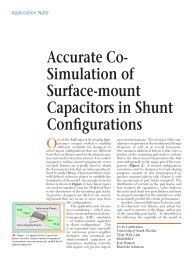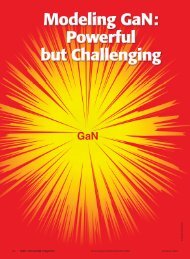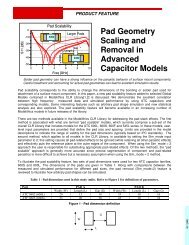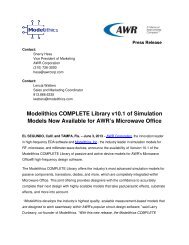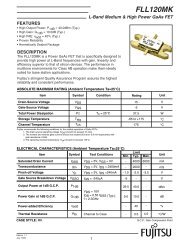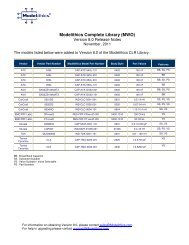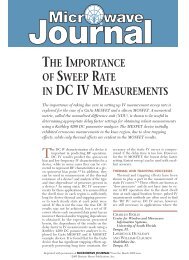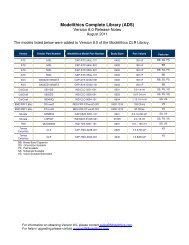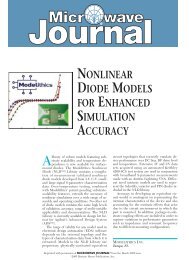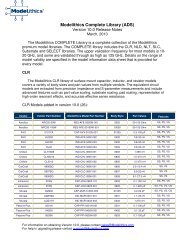MGA-86576 1.5 – 8 GHz Low Noise GaAs MMIC Amplifier Data Sheet
MGA-86576 1.5 – 8 GHz Low Noise GaAs MMIC Amplifier Data Sheet
MGA-86576 1.5 – 8 GHz Low Noise GaAs MMIC Amplifier Data Sheet
You also want an ePaper? Increase the reach of your titles
YUMPU automatically turns print PDFs into web optimized ePapers that Google loves.
<strong>MGA</strong>-<strong>86576</strong> Typical <strong>Noise</strong> Parameters [3] ,<br />
T C = 25°C, Z o = 50 Ω, V d = 5 V<br />
Frequency NF o Γopt<br />
4<br />
<strong>GHz</strong> dB Mag. Ang. R N/50 Ω<br />
1.0 2.1 0.56 27 0.43<br />
<strong>1.5</strong> 1.6 0.54 31 0.40<br />
2.5 <strong>1.5</strong> 0.47 40 0.36<br />
4.0 1.6 0.38 54 0.32<br />
6.0 1.8 0.28 77 0.28<br />
8.0 2.1 0.22 107 0.25<br />
[3] Reference plane taken at point where leads meet body of package.<br />
<strong>MGA</strong>-<strong>86576</strong> Applications Information<br />
Introduction<br />
The <strong>MGA</strong>-<strong>86576</strong> is a high gain, broad band, low noise<br />
amplifier. The use of plated through holes or an equivalent<br />
minimal inductance grounding technique placed<br />
precisely under each ground lead at the device is highly<br />
recom-mended. A minimum of two plated through holes<br />
undereachgroundleadispreferredwithfourbeinghighly<br />
suggested. A long ground path to pins 2 and 4 will add<br />
additionalinductancewhichcancausegainpeakinginthe<br />
2 to 4 <strong>GHz</strong> frequency range.This can also be accompanied<br />
by a decrease in stability. A suggested layout is shown in<br />
Figure 7. The circuit is designed for use on 0.031 inch thick<br />
FR-4/G-10 epoxy glass dielectric material.<br />
Printed circuit board thickness is also a major consideration.<br />
Thicker printed circuit boards dictate longer<br />
plated through holes which provide greater undesired<br />
inductance. The parasitic inductance associated with a<br />
pair of plated through holes passing through 0.031 inch<br />
thick printed circuit board is approximately 0.1 nH, while<br />
the inductance of a pair of plated through holes passing<br />
through0.062inchthickboardisabout0.2 nH.Avagodoes<br />
not recommend using the <strong>MGA</strong>-<strong>86576</strong> <strong>MMIC</strong> on boards<br />
thicker than 0.040 inch.<br />
Figure 7. Layout for <strong>MGA</strong>-<strong>86576</strong> Demonstration <strong>Amplifier</strong>.<br />
PCB dimensions are 1.18 inches wide by 1.30 inches high.<br />
The effects of inductance associated with the board<br />
material are easily analyzed and very predict-able. As a<br />
minimum, the circuit simulation should consist of the data<br />
sheetS-Parametersandanadditionalcircuitfiledescribing<br />
the plated through holes and any additional inductance<br />
associated with lead length between the device and the<br />
start of the plated through hole. To obtain a complete<br />
analysis of the entire amplifier circuit, the effects of the<br />
input and output microstriplines and bias decoupling<br />
circuits should be incorporated into the circuit file.<br />
Device Connections V d and RF Output (Pin 3)<br />
RF and DC connections are shown in Figure 8. DC power<br />
is provided to the <strong>MMIC</strong> through the same pin used to<br />
obtain RF output. A 50 Ω microstripline is used to connect<br />
the device to the following stage or output connector.<br />
A bias decoupling network is used to feed in V dd while<br />
simultaneously providing a DC block to the RF signal. The<br />
bias decoupling network shown in Figure 8, consisting of<br />
resistor R1, a short length of high impedance microstripline,<br />
and bypass capacitor C1, provides the best overall<br />
performance in the 2 to 8 <strong>GHz</strong> frequency range.<br />
27 pF<br />
100-1000 pF<br />
C1<br />
V dd<br />
HIGH Z<br />
10-100 Ω<br />
50 Ω 50 Ω 50 Ω 50 Ω<br />
2<br />
<strong>MGA</strong>-<strong>86576</strong> fig 8<br />
Figure 8. Demonstration <strong>Amplifier</strong> Schematic.<br />
L1<br />
1<br />
4<br />
R1<br />
3<br />
27 pF



